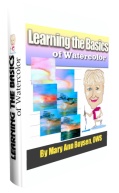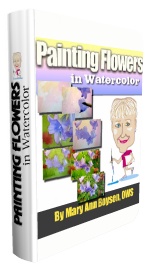Lesson 3:
We need to learn about stretching watercolor paper. I personally do not stretch and staple my paper down to a board, but for a beginner I recommend it in order to keep the paper from buckling, until you become more familiar with the medium. |
Related topics:
Using brushes
Glazing
Mixing colors |
- To stretch your paper, make sure the board is about an inch larger all the way around. Soak the paper in a clean tub of water (maybe 5 minutes, until it has absorbed the water). Lay it on a towel to absorb the excess moisture, then place it on the board.
- With a staple gun, begin stapling at one corner and continue to the end of that side. Move to another corner and staple toward the completed side, and repeat with the remaining sides.
- Allow to dry, so that it shrinks and maintains a taught surface. Re-wet before painting to use it for wet-in-wet painting.
Another way (my favorite) to stretch paper:
Have a non-absorbant surface such as Plexiglas, Gatorboard or Tempered Masonite.....then wet the paper with a large Hake brush on one side, then turn it over and wet the opposite side. It will stick down like glue.
There is a video I created to show this process on Youtube
The underside of the paper remains wet for a long time, which gives you the ability to blend colors more easily on the surface. I use 200# Waterford paper, as it is less likely to bubble up than 140# paper. If your paper has air bubbles underneath (lumps that appear on the surface), just pick it up at the corner or at one edge, and roll it up partially Then add more water to the back side, then roll it down carefully and the bubbles will disappear
This technique allows you to paint edge to edge and frame your work by floating it on a sheet of acid free matboard, showing the edges of the paper. People LOVE that!
<< Lesson 2: Value Scale
Lesson 4: Watercolor Horizons and Perspective>>
Return to Watercolor Lessons
Watercolor Painting Tips
Return to Watercolor Techniques
|
My E-Books

Learning the Basics of Watercolor

Painting Flowers in Watercolor

Painting on Watercolor Canvas
|

